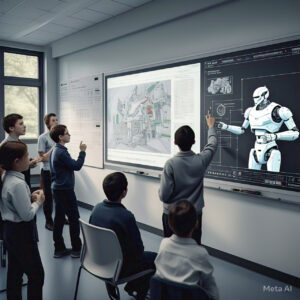Introduction: Imagine a group of young students gathered in a classroom, their faces lighting up as they watch a small robot they’ve built navigate a maze. This is the excitement a robotics club can bring to an elementary school! Starting a robotics club is an excellent way to introduce children to STEM (Science, Technology, Engineering, and Mathematics), making learning both fun and practical. If you’re interested in sparking curiosity and creativity among students, here’s a step-by-step guide to help you get started.
1. Gauge Interest and Gather Support
Before diving into the planning phase, it’s important to determine if there’s enough interest among students, teachers, and parents. You can:
- Survey students to see how many are interested in robotics and coding.
- Discuss with teachers who might want to be involved or provide support.
- Connect with parents to gauge their willingness to volunteer or support the club.
Tip: A strong start is easier with a group of enthusiastic kids and supportive adults!
2. Define the Club’s Goals and Structure
Setting clear goals for your club is crucial. Consider questions like:
- What age group will the club target?
- Will the focus be on building simple robots, learning to code, or participating in competitions?
- How often will the club meet? Weekly, bi-weekly, or monthly?
For elementary students, start with simple projects to keep them engaged and gradually introduce more complex concepts.
3. Plan Your Budget and Gather Resources
Robotics can be an expensive hobby, but it doesn’t have to be. Here’s how to manage it:
- Create a budget that covers the basics like robotics kits, laptops/tablets, and miscellaneous materials (screws, wires, etc.).
- Seek funding through school budgets, local businesses, or crowdfunding. You can also apply for grants focused on STEM education.
- Choose beginner-friendly robotics kits like LEGO Mindstorms, VEX Robotics, or Sphero, which are great for younger kids and come with easy-to-follow guides.
Did you know? According to a study by Code.org, schools with strong STEM programs see a 30% increase in student engagement and interest in related fields!
4. Find a Mentor or Advisor
Having an experienced mentor or advisor can make a huge difference. Look for:
- Teachers with a passion for STEM who can help guide activities.
- Parents or local professionals in engineering or tech fields willing to volunteer.
- High school or college students who are part of robotics teams and can offer mentorship.
- Mentors can provide technical expertise and inspire students with real-world applications of robotics.
5. Create a Fun and Engaging Curriculum
A well-structured curriculum is key to keeping young students interested. Begin with straightforward projects that introduce basic concepts and build a foundation. Some ideas include:
- Basic robotics challenges like building a robot that can move in a straight line or follow a path.
- Introduction to coding with block-based programming languages like Scratch or Blockly.
- Hands-on activities like creating obstacle courses for robots or programming them to perform specific tasks.
Pro Tip: Integrate fun themes, like building robots to navigate a “rescue mission” or “space exploration,” to keep students excited.learn more
6. Promote the Club and Recruit Members
Promote your new robotics club by using the following methods:
- Posters and flyers around the school.
- Announcements in school newsletters or during morning assemblies.
- Social media updates on the school’s pages to reach parents.
Consider hosting an introductory session where students can see a simple robotics demonstration or try a hands-on activity. This can help spark their interest and encourage them to join.
7. Organize Events and Competitions
To keep the excitement high, plan events like:
- Show-and-tell sessions where students can showcase their projects.
- In-school competitions where students can work in teams to solve fun challenges.
- Participation in regional or national competitions like the First LEGO League or VEX IQ Challenge, which can motivate students to take their skills to the next level.
8. Encourage Teamwork and Creativity
Robotics is not just about building machines; it’s also about fostering collaboration, problem-solving, and creative thinking. Encourage students to:
- Work in teams, sharing ideas and responsibilities.
- Brainstorm solutions to problems they encounter during projects.
- Experiment freely, knowing that making mistakes is part of the learning process.
9. Seek Feedback and Continuously Improve
After a few sessions, gather feedback from students, parents, and volunteers. Use their input to improve the club’s activities and structure. This iterative process will help keep the club relevant and engaging for its members.
Ready to inspire the next generation of engineers and inventors at your school!
Start planning your robotics club today! With the right resources and a bit of enthusiasm, you can create a fun, educational experience that ignites a lifelong passion for STEM. Need more tips and resources? Visit our website to learn how you can bring engaging STEM activities to your school!















